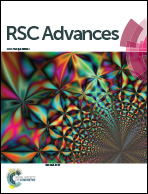Graphene-iron oxide nanocomposite (GINC): an efficient catalyst for ammonium perchlorate (AP) decomposition and burn rate enhancer for AP based composite propellant†
Abstract
A facile and ecofriendly method for the synthesis of nano-sized iron oxide (Fe2O3) decorated graphene (GINC) hybrid by ultrasonication via microwave irradiation has been developed. During this process, nano-sized Fe2O3 particles with a size of approximately 20–30 nm were uniformly decorated over a graphene sheet. The nanohybrid was characterized by XRD, HRTEM, Raman spectroscopy and Raman mapping. To study the enhancement of catalytic activity of iron oxide by preparing GINC, several AP based compositions containing 1–5 weight% GINC were made and characterized through simultaneous thermal analysis (STA). Along with this, formulations with other catalysts with 1–5 weight% concentrations were also prepared and evaluated. Experimental results showed that GINC with 5 weight% concentration was considerably more effective as compared to other compositions. To further extend this application as a burn rate enhancer in composite propellants, several formulations of composite propellants containing 1 part of different burn rate enhancers, such as Fe2O3, nano-sized Fe2O3 and GINC, were prepared and evaluated using theoretical prediction, viscosity, ballistic properties, sensitivity parameter and thermophysical properties. To quantify the burn rate enhancement in the presence of GINC, burn rate measurement, STA, DSC and activation energy calculation were performed. The results show that the burn rate of propellant increases from micron-sized Fe2O3 (30% increases) to nano-sized Fe2O3 (37% increase). In the presence of GINC, a significant increase (52%) in burn rate is achieved. In GINC, effective iron content is about 50% as compared to nano- and micron-sized Fe2O3. Hence, GINC was found to be an excellent burn rate modifier for an advanced AP based propellant system.


 Please wait while we load your content...
Please wait while we load your content...